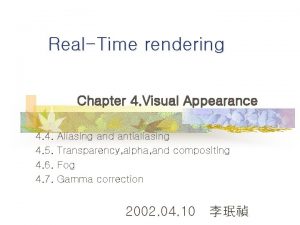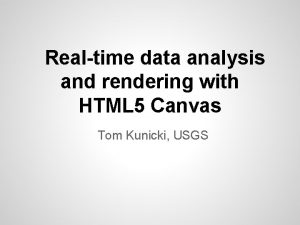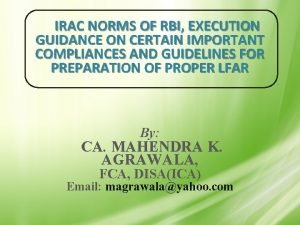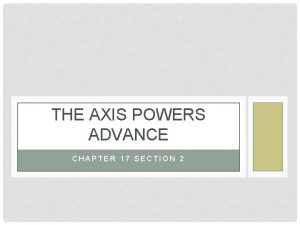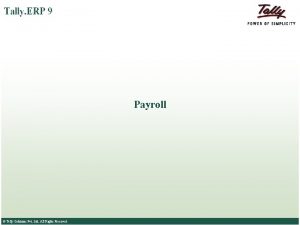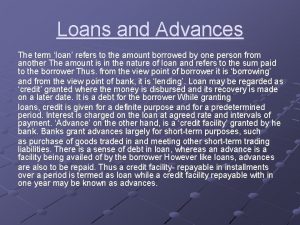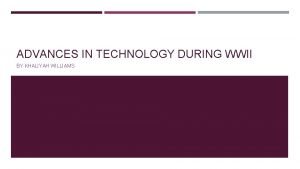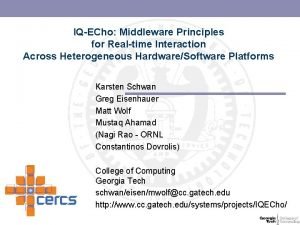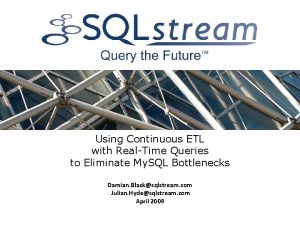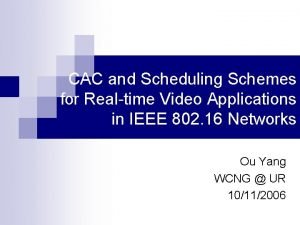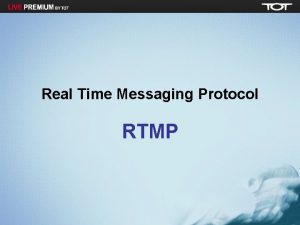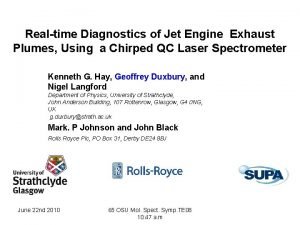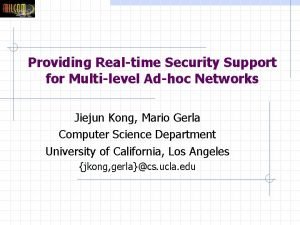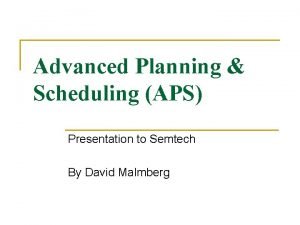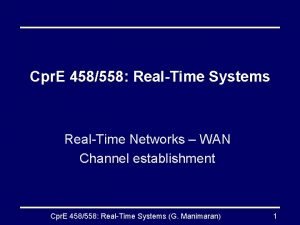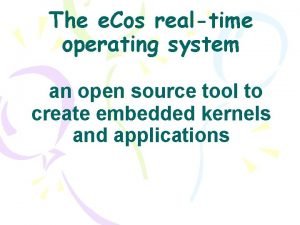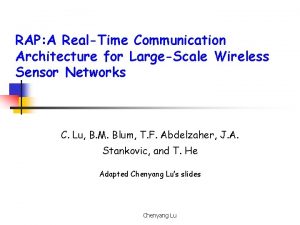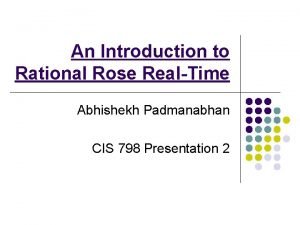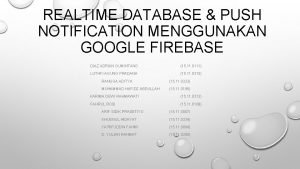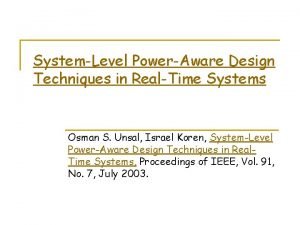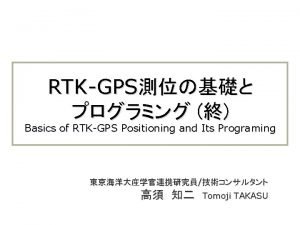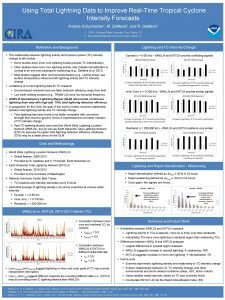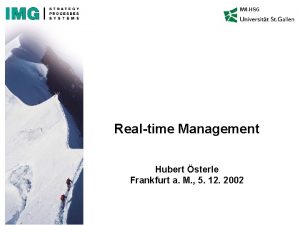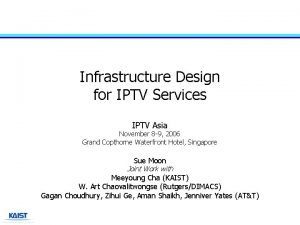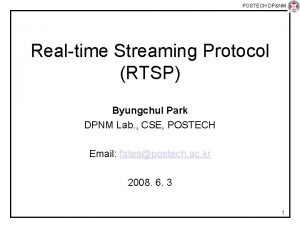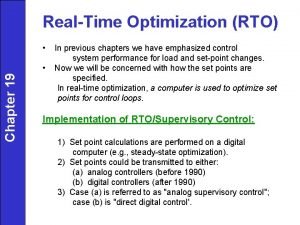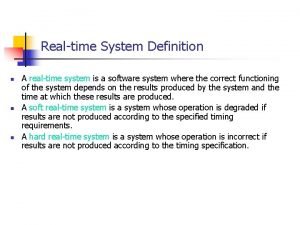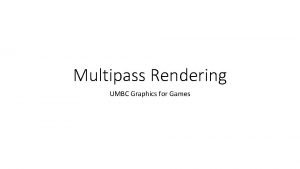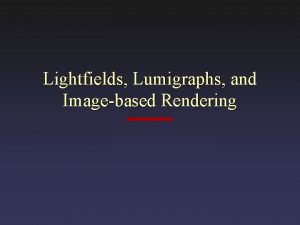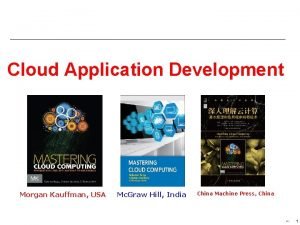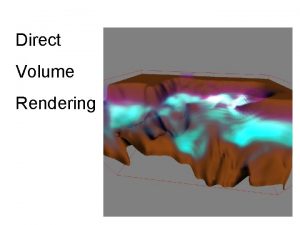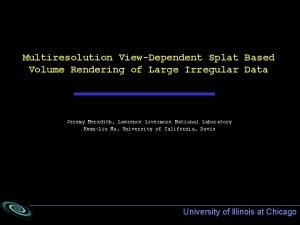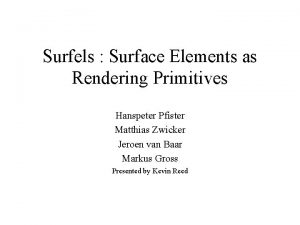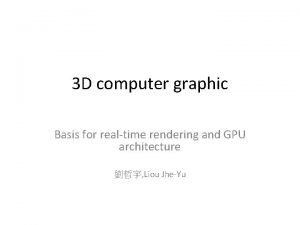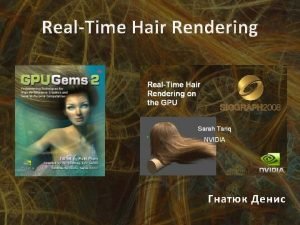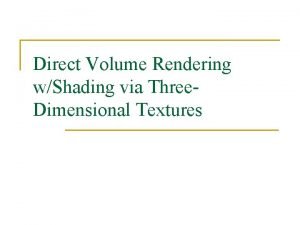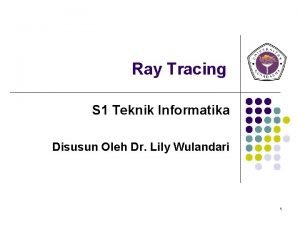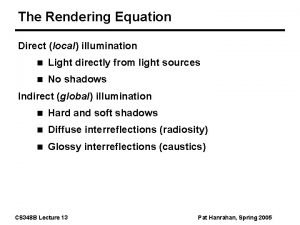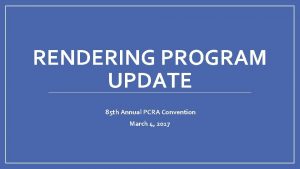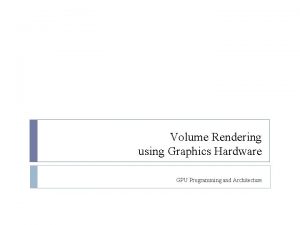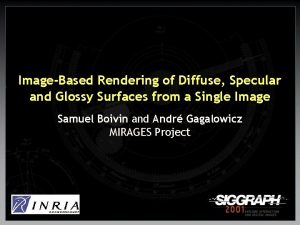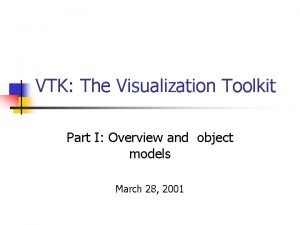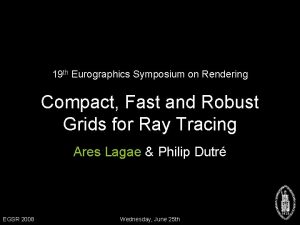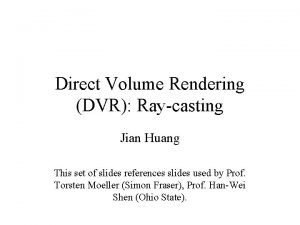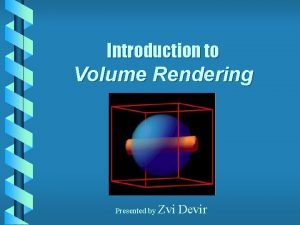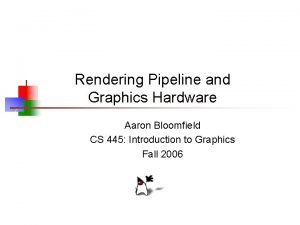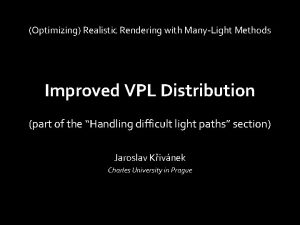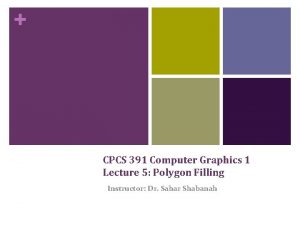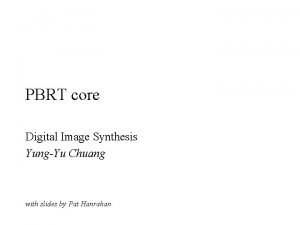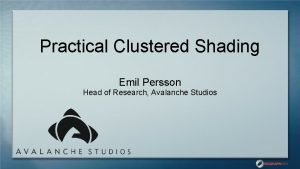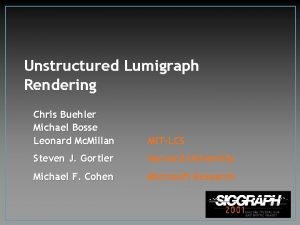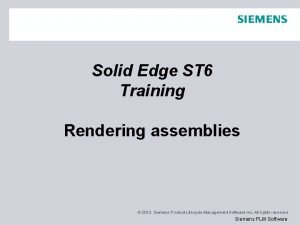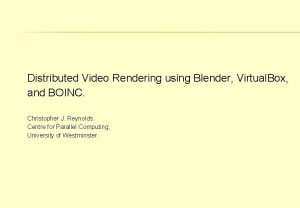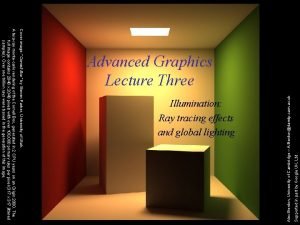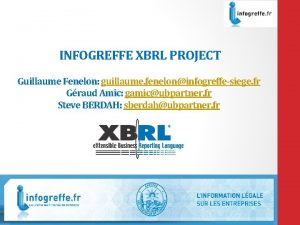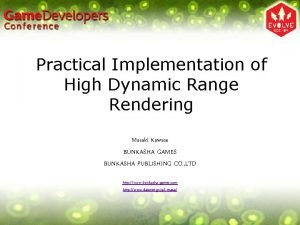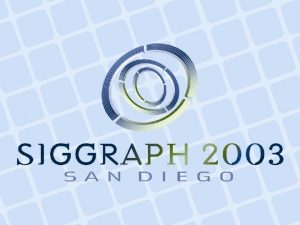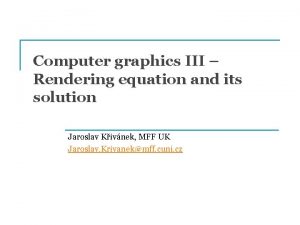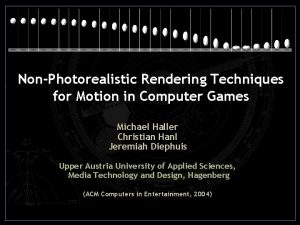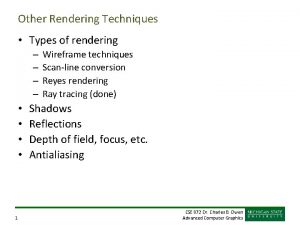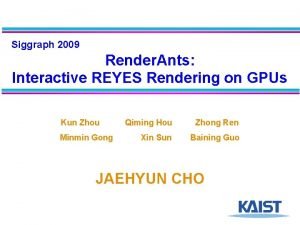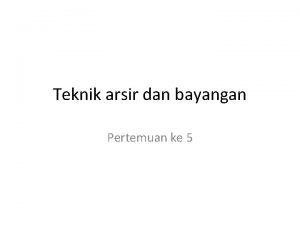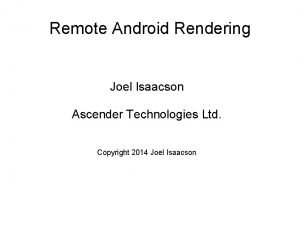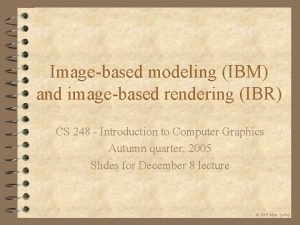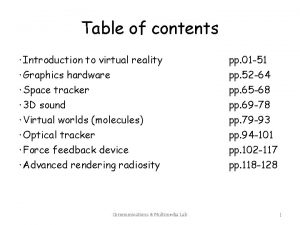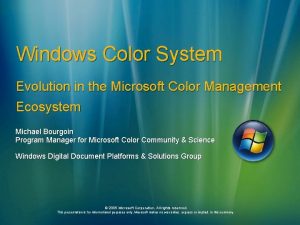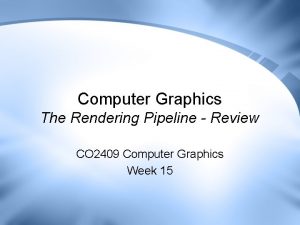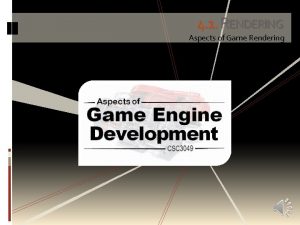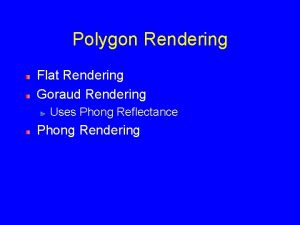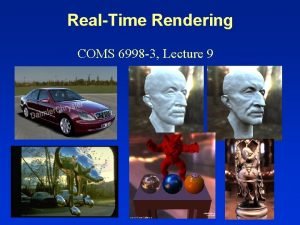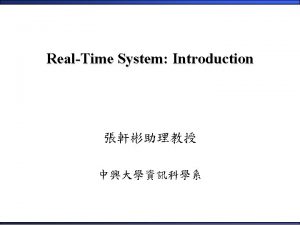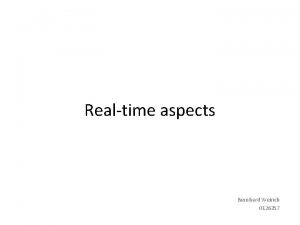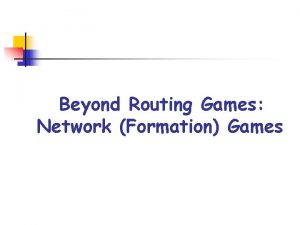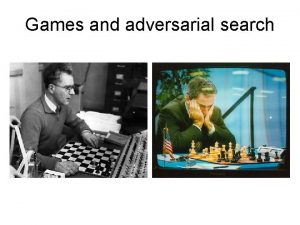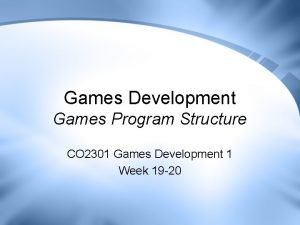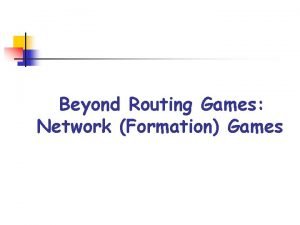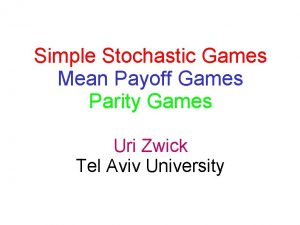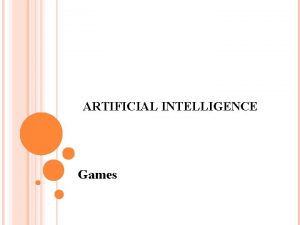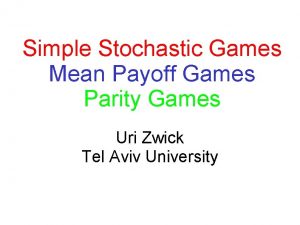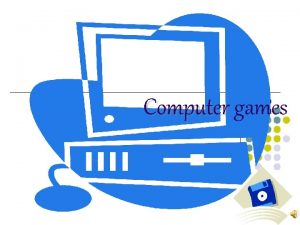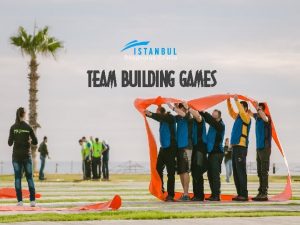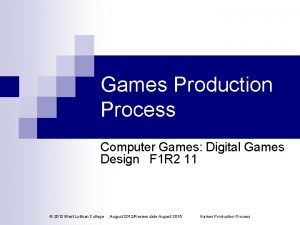Advances in RealTime Rendering in Games More Performance








































![CSM Cuboids §Evaluate as a separate pass [Sousa 08] –Input is depth buffer –Creates CSM Cuboids §Evaluate as a separate pass [Sousa 08] –Input is depth buffer –Creates](https://slidetodoc.com/presentation_image_h2/708ae181ac3a43201e54300cbcc2cff5/image-41.jpg)













































![SSAO in Frostbite 2 (2/) Line sampling, from Volumetric Obscurance [Loos 10] SSAO in Frostbite 2 (2/) Line sampling, from Volumetric Obscurance [Loos 10]](https://slidetodoc.com/presentation_image_h2/708ae181ac3a43201e54300cbcc2cff5/image-87.jpg)










- Slides: 97

Advances in Real-Time Rendering in Games

More Performance! Five Rendering Ideas from Battlefield 3 and Need For Speed: The Run John White (NFS) Colin Barré-Brisebois (BF 3) Advances in Real-Time Rendering in Games

Agenda §Motivations §The Techniques §Separable Bokeh Depth-of-Field §Hi-Z / Z-Cull Reverse Reload Tricks §Chroma Sub-Sampled Image Processing §Tiled-Based Deferred Shading on Xbox 360 §Temporally-Stable Screen-Space Ambient Occlusion §Q&A Advances in Real-Time Rendering in Games

Motivations §Frostbite 2 is DICE’s Next-Generation Engine for Current Generation Platforms § 5 Pillars: § Animation § Audio § Scale § Destruction § Rendering §Powers Battlefield 3 and Need For Speed: The Run Advances in Real-Time Rendering in Games

More Info §Lots of FB 2 papers on DICE website §publications. dice. se §Also see Alex Ferrier’s talk on “ 1000 points of light” Tues, 2 pm, East Building, Ballroom A/B Advances in Real-Time Rendering in Games

Advances in Real-Time Rendering in Games

Advances in Real-Time Rendering in Games

Separable Bokeh Depth-of-Field Advances in Real-Time Rendering in Games

Real World Bokeh - Disc Photo Courtesy of Mohsin Hasan 2011 Advances in Real-Time Rendering in Games

Real World Bokeh – Pentagonal Photo Courtesy of Mohsin Hasan 2011 Advances in Real-Time Rendering in Games

Circle of Confusion Calculation §Calc per pixel Co. C from real world camera parameters §Lens Length (derive from FOV) §F/Stop §Focal Plane §Co. C is a simple MADD on the raw Z Depth [Demers 04][Jones 08] Co. C = abs(z * Co. CScale + Co. CBias) Co. CScale = (A * focallength * focalplane * (zfar - znear)) / ((focalplane - focallength) * znear * zfar) Co. CBias = (A * focallength * (znear - focalplane )) / ((focalplane * focallength) * znear) Advances in Real-Time Rendering in Games

Pre Multiplied Co. C §For 16 -bit source pre multiply the Co. C by the colour §Store Co. C in alpha §Recover colour by doing col. rgb /= col. a §Ensure Co. C always has a small number so colour can always be recovered Advances in Real-Time Rendering in Games

Blur Process §Gaussian blur §Common in DX 9 games. Cheap § 2 D Area samples §Limited kernel size before texture tap explosion §GS expanded Point Sprites §Heavy fill rate §Cry. Engine 3 DX 11 and Unreal Engine 3 Samaritan demo Advances in Real-Time Rendering in Games

Gaussian vs. real world bokeh §Arbitrary blurs in image space are O(N^2) §Gaussian blurs can be made separable O(N) §What 2 D blurs can be made separable? §Gaussian §Box §Skewed Box Advances in Real-Time Rendering in Games

Other separable blurs §Gaussian, Box and Skewed Box Advances in Real-Time Rendering in Games

Hexagonal Blurs §Decompose a hexagon into 3 rhombi §Each rhombi can be computed via separable blur § 7 Passes in total. 3 shapes x 2 blurs + 1 combine 1 2 3 Advances in Real-Time Rendering in Games First Pass Second Pass

Hexagonal Blurs – Pass Reduction §Hexagonal blur using a separable filter §But 7 passes and 6 blurs is not competitive §Need to reduce passes 1 2 3 Advances in Real-Time Rendering in Games First Pass Second Pass

Hexagonal Blurs – Pass Reduction 1 Pass 2 Pass 1 Up Down Left + Advances in Real-Time Rendering in Games Pass 2 Down Left + Down Right

Hexagonal blurs – Pass reduction 2 Pass 1 Pass 2 + + Advances in Real-Time Rendering in Games

Hexagonal Bokeh Advances in Real-Time Rendering in Games

Hexagonal Bokeh Advances in Real-Time Rendering in Games

Hexagonal Bokeh Advances in Real-Time Rendering in Games

Hexagonal Bokeh Advances in Real-Time Rendering in Games

Hexagonal vs Gaussian § 2 Passes with a total of 2 blurs §Hexagonal § 2 Passes (3 resolves) with a total of 4 blurs §BUT each blur only needs half the taps therefore same #taps §BUT each tap contributes equally unlike Gaussian so need less taps for a given aesthetic filter kernel width! §PLUS We can improve further Advances in Real-Time Rendering in Games

Iterative Refinement §Because we have equal weighted blurs can use iterative refinement on the blurring [Sousa 08] §Multiple passes fill in the under-sampling §Dual iteration blur needs a total of 5 passes with a total of 8 half blurs. Advances in Real-Time Rendering in Games

Iterative Refinement Pass 1 Pass 2 Pass 3 Pass 5 + + Pass 4 Advances in Real-Time Rendering in Games

Pseudo Scatter filter §Proper bokeh should have its blur scattered to its neighbours §However pixel shaders are designed to gather they can’t scatter the results §Typical blurs default the filter kernel to the Co. C of pixel §Instead, default to big Co. C and reject based on the sampled texel Co. C –Extra method to stop bleeding artifacts and can sharpen up smooth gradients Advances in Real-Time Rendering in Games

Hi Z culling §When downsampling the premultiplied Co. C buffer output the computed Co. C as depth §You can then draw the plane at Z depth of 0. 001 f §In focus pixels will be quickly rejected by Hi Z §Same for iterative refinement §Draw undersample pass at higher Z value, fine at small Z value –Requires an explicit copy afterwards to re-fill Advances in Real-Time Rendering in Games

Hi-Z / Z-Cull Reverse Reload Tricks Advances in Real-Time Rendering in Games

Hi-Z (1/) • Ubiquitous on modern hardware • Stores a Low Res version of the Z buffer • Can use this to conservatively reject groups of pixels • Saves fragment shading known occluded pixels Advances in Real-Time Rendering in Games

Hi-Z (2/) Advances in Real-Time Rendering in Games

Hi-Z (3/) Empty Space Advances in Real-Time Rendering in Games Solid Space

Volume Rendering (1/) • In Deferred Renderers it is common to reproject screen pixels back into world space –Common for lights (point, spot, line) –Shadow volumes • Draw a convex bounding polyhedron projected in screens space • In shader, reject pixels which are not in the volume bounds Advances in Real-Time Rendering in Games

Volume Rendering (2/) B A C Advances in Real-Time Rendering in Games

Reverse Hi-Z Reload (X 360) §Alias a Render Target on existing depth buffer §Init aliased RT to D 3 DHIZFUNC_GREATER_EQUAL §Draw Full screen quad –NULL Pixel Shader –Zfunc == Never §Hi-Z is now primed in reverse §Similar technique on Playstation 3 (See Dev. Net) Advances in Real-Time Rendering in Games

Reverse Hi-Z (1/) Empty Space Solid Space Advances in Real-Time Rendering in Games Solid Space Empty Space

Reverse Hi-Z (2/) §The GPU will now cull fragments if they are closer than the value in the depth buffer §By rendering the backfaces of convex polyhedra, pixels beyond the faces will quickly reject §If the camera is inside the volume then only pixels inside the volume will pass §Perfect for cascaded shadow maps Advances in Real-Time Rendering in Games

Reverse Hi-Z (3/) B A C Advances in Real-Time Rendering in Games

Reverse Hi-Z for CSM rendering §Each cascade for a directional light is bounded by a cuboid in world space §Only world space pixels inside the cuboid will project onto the shadow map §By drawing the cuboid backfaces only these pixels will pass the reverse Z test Advances in Real-Time Rendering in Games

CSM Cuboids CSM 1 CSM 0 C A B Advances in Real-Time Rendering in Games
![CSM Cuboids Evaluate as a separate pass Sousa 08 Input is depth buffer Creates CSM Cuboids §Evaluate as a separate pass [Sousa 08] –Input is depth buffer –Creates](https://slidetodoc.com/presentation_image_h2/708ae181ac3a43201e54300cbcc2cff5/image-41.jpg)
CSM Cuboids §Evaluate as a separate pass [Sousa 08] –Input is depth buffer –Creates a L 8 mask texture input into directional light pass §Can do a prior full screen pass to tag back facing pixels wrt to light source in stencil –Heuristic on sun angle with camera §Potential for ¼ res with bilateral upsample §Stencil is updated to denote already processed pixels Advances in Real-Time Rendering in Games

Reverse Hi-Z CSM (1/) §Cascade 0 Advances in Real-Time Rendering in Games

Reverse Hi-Z CSM (2/) §Cascade 1 Advances in Real-Time Rendering in Games

Reverse Hi-Z CSM (3/) §Cascade 2 Advances in Real-Time Rendering in Games

Reverse Hi-Z CSM (4/) §Cascade 3 Advances in Real-Time Rendering in Games

Min/Max Shadow Maps (1/) §Downsample and dilate SM, keeping track of min and max depths Advances in Real-Time Rendering in Games

Min/Max Shadow Maps (2/) §Dilated min/max SM allow us to know if a pixel is. . . –Fully In shadow –Fully out of shadow –Partially in shadow (conservatively) §Draw each cuboid twice §First Pass –Single simple tap shader §Second Pass –High quality PCF shader Advances in Real-Time Rendering in Games

Min/Max Shadow Maps Simple Pass § If Z < Min. Max. min return (1, 1, 1, 1) If Z > Min. Max. maxreturn (0, 0, 0, 1) If Z < Min. Max. min return (0, 0, 0, 0) Mask Stencil Advances in Real-Time Rendering in Games

Min/Max Shadow Maps PCF Pass (1/) § Second pass is standard PCF filter Mask Stencil Advances in Real-Time Rendering in Games

Min/Max Shadow Maps (3/) § Do for all cascades Advances in Real-Time Rendering in Games

Min/Max Shadow Maps PCF Pass (2/) § Final Overdraw Advances in Real-Time Rendering in Games

Conditional Tests §When we render the cuboid we can count how many pixels pass §If Zero then no pixels will sample from the shadow map –So why even render the shadow map! –Draw the cuboid first and only if pixels pass draw the actual shadow map §Zero passed pixels occur for two reasons –All pixels are further away –All pixels have been touched by a closer cascade (stencil cleared) Advances in Real-Time Rendering in Games

Chroma Sub-Sampled Image Processing Advances in Real-Time Rendering in Games

Chroma Sub-Sampling §Not a new idea. Used in TV broadcasts as well as Jpeg/Mpeg compression §Decompose image into luminance and chroma §Store Luma at full res only. Chroma at lower Advances in Real-Time Rendering in Games

Chroma Sub-Sampling - Motivation §Post processing requires lots of bandwidth §Easy to optimise ALU down §Quickly hit a performance ceiling, especially for 16 bpp pixels §Reading and writing a 720 p image with 16 bpp components is 14 MB bandwidth §Assuming 14 GB/Sec Bandwidth and perfect cache usage this is 1 ms for a single pass RED Green Blue X Advances in Real-Time Rendering in Games

Chroma Sub Sampling - Motivation §Instead reduce down to Luma only §¼ of the bandwidth required §Requires extra processing on the Colour §But this can be 2 channel at ¼ res ( 1/8 original size ) §Also can get away with less taps Luma Cb Cr Advances in Real-Time Rendering in Games

Chroma Sub Sampling §Bandwidth is reduced to 1/4 §So, are the shaders now 4 X quicker? §No. We are ALU bound again §Texture units and ALU are designed for 4 component SIMD §We are only using 1 component §Need to pack 4 luma values together and process together Advances in Real-Time Rendering in Games

Chroma Sub Sampling §Pack 4 adjacent pixels together into one RGBA pixel §Only need 1 texread to get 4 luma values §So a 1280 x 720 luma buffer is a 320 x 720 ARGB buffer §With the packed buffer bilinear filtering is not correct §Have to manually filter horizontally using DOTP §Colin will go into this later Advances in Real-Time Rendering in Games

Chroma Sub Sampling Advances in Real-Time Rendering in Games

Chroma Sub Sampling Advances in Real-Time Rendering in Games

Butterfly Packing §Overlay each quadrant into ARGB §Mirror around the image center point §Bilinear now works except across the boundaries • Re-draw a strip with additive blend and swizzling • R<->G and B<->A for horizontal • R<->B and G<->A for vertical §Radial blurs just work Advances in Real-Time Rendering in Games

Butterfly Unpacking §When rendering fullscreen quad, need two attributes 0, 0 640, -360, -360 0, 2 -640, 360, -360 2, 0 -640, -360, -360 Use UV in Mirror Mode Dot with saturated second component 2, 2 -640, -360, 360 Advances in Real-Time Rendering in Games

Future Work §Use for hexagonal blurs §Output packed tonemap • Only perform temporal AA for luma • Packed luma used for MLAA passes Advances in Real-Time Rendering in Games

Tiled-based Deferred Shading on Xbox 360 Advances in Real-Time Rendering in Games

Tiled-based Deferred Shading? (1/) §Want more interesting lighting with more dynamic lights! §Platform is fixed better usage of rendering resources §[Swoboda 09] and [Coffin 11] on Playstation 3™, by [Andersson 09] in Direct. Compute, and other hybrids §Christina, Johan and I teamed-up for this version on 360 §Load-balance and compute lighting where it matters: 1. Divide the screen in screen-space tiles 2. Cull analytical lights (point, cone, line), per tile 3. Compute lighting for all contributing lights, per tile Advances in Real-Time Rendering in Games

Tiled-based Deferred Shading? (2/) Advances in Real-Time Rendering in Games

Tiled-based Deferred Shading? (3/) Advances in Real-Time Rendering in Games

Tiled-based Deferred Shading? (4/) Advances in Real-Time Rendering in Games

Tiled-based Deferred Shading? (5/) Advances in Real-Time Rendering in Games

How Does This Fit on Xbox 360? §We don't have Direct. Compute nor SPUs on 360. . . §Fortunately, Xenos is powerful, and will crunch ALU §For maximal throughput, data at rendering time has to be cleverly pre-digested §If timed properly, we can also use the CPUs to help the GPU along the way. . . §GPU is better at analyzing a scene than CPUs… §Let’s use it to classify the scene Advances in Real-Time Rendering in Games

GPGPU Culling (1/) §Our screen is divided in 920 tiles of 32 x 32 pixels §Downsample and classify the scene from 720 p to 40 x 23 (1 pixel == 1 tile) §Find each tile’s Min/Max depth §Find each tile’s material permutations §Downsampling is done in multi-pass and via MRTs §Similar to [Hutchinson 10] Advances in Real-Time Rendering in Games

GPGPU Culling (2/) Advances in Real-Time Rendering in Games

GPGPU Culling (3/) Advances in Real-Time Rendering in Games

GPGPU Culling (4/) Advances in Real-Time Rendering in Games

GPGPU Culling (5/) §Build mini-frustas for each tile §Cull lights against sky-free tiles in a shader §Store the culling results in a texture: §Column == Light ID §Row == Tile ID §Actually, 4 lights can be processed at once (A-R-G-B) §Read back the contribution results on the CPU and prepare for lighting! Advances in Real-Time Rendering in Games

I Need a Light §Parse the culling results texture on CPU §For each light type, For each tile, For each material permutation, §Regroup & set the light parameters for the PS constants §Setup the shader loop counter* §Additively render lights with a single draw call (to the final HDR lighting buffer) Advances in Real-Time Rendering in Games

Results (1/) Advances in Real-Time Rendering in Games

Results (2/) Advances in Real-Time Rendering in Games

Timeline GPU CPU G-Buffer DS Other C Other Light Prepare §DS: Downsample / Classify §C: Cull §Light: Lighting pass §We kick CPU jobs from the GPU using a MEMEXPORT shader (i. e. : write token at specific address, job starts) Advances in Real-Time Rendering in Games

Don’t Upset The GPU (1/) §Constant Waterfall sucks! §This WILL kill performance §To prevent, use the a. L register when iterating over lights [Pritchard 10] §If set properly, ALU / lighting will run at 100% efficiency §In C++ Code int light. Counter[4] = { count, start, step, 0 }; p. Device->Set. Pixel. Shader. Constant. I(0, light. Counter, 1); Advances in Real-Time Rendering in Games

Don’t Upset The GPU (2/) int tile. Light. Count : register(i 0); float 4 light. Params[NUM_LIGHT_PARAMS] : register(c 0); start count*step [loop] for (int i. Light = 0; i. Light < tile. Light. Count; i. Light++) { float 4 params 1 = light. Params[i. Light + 0]; float 4 params 2 = light. Params[i. Light + 1]; float 4 params 3 = light. Params[i. Light + 2]; … } step // mov r 0 c 0[0+a. L] // mov r 1 c 0[1+a. L] // mov r 2 c 0[2+a. L] Advances in Real-Time Rendering in Games

Don’t Upset The GPU (3/) §Use Dr. PIX, and check shader disassembly! §These shaders are ALU bound §Simplify your math, especially in the loops! §Get rid of complicated non 1: 1 instructions (e. g. smoothstep) §Play with microcode: -normalize(v) is faster than normalize(-v) §Move code around to help with dual-issuing: /* 14 */ this mul r 5. xyz, r 4. yzx + mulsc r 0. w, c 254. y, r 0. z §Use shader predicates to help the compiler ([flatten], [branch], [isolate], [if. Any], [if. All]), and tweak GPRs! Advances in Real-Time Rendering in Games

Don’t Upset The GPU (4/) §Use GPU freebies §Texture sampler scale/bias (*2 -1) §Simplify / remove unneeded code via permutations §Upload constants via the constant buffer pointers §We use async pre-compiled command buffers (APCBs) §Keep them lean & mean (check contents in PIX) §For more info, check out Ivan’s awesome presentation from Gamefest 2011 [Nevraev 11] Advances in Real-Time Rendering in Games

Performance Light Type (8 lights/tile, every tile) Performance Point 4. 0 ms Point (with Spec) 7. 8 ms Cone 5. 1 ms Cone (with Spec) 5. 3 ms Line 5. 8 ms §Classification: 1. 35 ms (with resolves) Advances in Real-Time Rendering in Games

Temporally-stable Screen-Space Ambient Occlusion Advances in Real-Time Rendering in Games

SSAO in Frostbite 2 (1/) §SSAO for mid-range PC & consoles, HBAO for high-end PC §Line sample [Loos 10], with linear depth in a texture §Linearize depth for better precision/distribution k. Z = – far * near / (far – near); k. W = far / (far – near) linear. Depth = k. Z / (z - k. W) §Sample linear depth texture with linear sampling §Scale SSAO parameters over distance §Final compositing with Hi-Stencil, reject sky pixels § 4 x 4 random noise texture is sufficient, 1: 1 (texel: pixel) Advances in Real-Time Rendering in Games
![SSAO in Frostbite 2 2 Line sampling from Volumetric Obscurance Loos 10 SSAO in Frostbite 2 (2/) Line sampling, from Volumetric Obscurance [Loos 10]](https://slidetodoc.com/presentation_image_h2/708ae181ac3a43201e54300cbcc2cff5/image-87.jpg)
SSAO in Frostbite 2 (2/) Line sampling, from Volumetric Obscurance [Loos 10]

HBAO in Frostbite 2 Advances in Real-Time Rendering in Games

SSAO in Frostbite 2 (1/) Advances in Real-Time Rendering in Games

Blurring the line (1/) §Dynamic AO is done best with edge-preserving blur / bilateral filtering §On consoles, we have really tight budgets §Scenes are pretty action-packed, halos not too noticeable §AO should be a subtle effect §We need to find the fastest way to blur AO, and has to look soft! (e. g. : 9 x 9 Gaussian, with bilinear) Advances in Real-Time Rendering in Games

Fast Grayscale Blur - 8 as 8888 (1/) §Reduce the number of taps: aliasing the AO results from R 8 as A 8 R 8 G 8 B 8 § 1 horizontal tap == 4 taps (ARGB) §Combine with bilinear sampling (vertical pass only) § 9 x 9 Gaussian = 3 horizontal taps and 5 vertical taps §On PS 3: alias the memory directly §On 360: Formats are different in memory, use resolve remap textures. See Fast. Untile XDK sample. Advances in Real-Time Rendering in Games

Fast Grayscale Blur (1/) Horizontal Vertical 9 “samples” 3 point taps 9 “samples 5 bilinear taps Advances in Real-Time Rendering in Games

Fast Grayscale Blur (2/) For a 640 x 360 SSAO Buffer (720 p / 2) Technique Play. Station 3 Xbox 360 9 x 9 Gaussian 0. 5 ms 0. 65 ms (0. 52 ms + 0. 132 ms resolve) 9 x 9 Gaussian (Bilinear, as R 8) 0. 40 ms 0. 43 ms (0. 3 ms + 0. 132 ms resolve) 9 x 9 Gaussian (Bilinear, as A 8 R 8 G 8 B 8) 0. 10 ms 0. 18 ms (0. 143 ms + 0. 034 ms resolve) Average (total) AO performance (compute + blur + blit) : (360: 1. 25 -1. 5 ms ; PS 3: 1. 5 -2. 0 ms) Advances in Real-Time Rendering in Games

Thank You § Christina Coffin § Johan Andersson § Ivan Nevraev § Daniel Collin § Khalid Khalkhouli § Andrew Routledge § Stephen Hill § Aurelio Reis § Alex Ferrier § Fredrik Seehussen § Alex Fry § Natalya Tatarchuk § Mohsin Hasan Advances in Real-Time Rendering in Games

Questions John White – Bokeh, Z Cull Reverse Reload, Chroma Subsampling Colin Barré-Brisebois – Tile-based Deferred Shading, SSAO Advances in Real-Time Rendering in Games

References (1/) ANDERSSON, J. , “Parallel Graphics in Frostbite - Current & Future”, Beyond Programmable Shading, SIGGRAPH 2009. BAVOIL, L. , SAINZ, M. , and DIMITROV, R. , “Image-space horizon-based ambient occlusion”, SIGGRAPH 2008. COFFIN, C. , “SPU Based Deferred Shading for Battlefield 3 on Playstation 3”, GDC 2011. DEMERS, J. , “Depth of Field : A Survey of Techniques”, GPU Gems, Ch. 23. HUTCHINSON, N. et al. , “Screen Space Classification for Efficient Deferred Shading”, SIGGRAPH 2010. JONES, M. , Optimal Co. C Calculation, Rendering @ EA internal mail, 2008. Advances in Real-Time Rendering in Games

References (2/) LOOS, B. J. , and SLOAN, P-P. , “Volumetric Obscurance”, 2010. NEVRAEV, I. , “Xbox 360 Precompiled Command Buffers”, Microsoft Gamefest London 2011. PRITCHARD, C. , “Xbox 360 Shaders and Performance: How Not to Upset the GPU”, Microsoft Gamefest Seattle 2010. SOUSA, T. , “Crysis Next Gen Effects”, GDC 2008. SWOBODA, M. , “Deferred Lighting and Post-Processing on PLAYSTATION® 3”, GDC 2009. KAWASE, M. , “Frame Buffer Postprocessing Effects in DOUBLE-S. T. E. A. L (Wreckless), GDC 2003. Advances in Real-Time Rendering in Games
 More more more i want more more more more we praise you
More more more i want more more more more we praise you More more more i want more more more more we praise you
More more more i want more more more more we praise you Advances in real-time rendering in games
Advances in real-time rendering in games Rendering realtime compositing
Rendering realtime compositing Rendering realtime compositing
Rendering realtime compositing Chapter 23 hunger games questions
Chapter 23 hunger games questions Types of games indoor and outdoor
Types of games indoor and outdoor Lesson 9.1 intellectual advances in the first year
Lesson 9.1 intellectual advances in the first year Irac guidelines
Irac guidelines Recent advances in ceramics
Recent advances in ceramics Axis powers
Axis powers Photodesintegration
Photodesintegration Lurbinectedin posologie
Lurbinectedin posologie Taly payroll
Taly payroll What is long term loans and advances
What is long term loans and advances Advances in memory technology
Advances in memory technology Advances in technology during wwii
Advances in technology during wwii Opto-electronic advances
Opto-electronic advances Realtime interaction
Realtime interaction Realtime etl
Realtime etl Cac realtime
Cac realtime Realtime it
Realtime it Ecurisa
Ecurisa Real time messaging protocol
Real time messaging protocol Realtime diagnostics
Realtime diagnostics Ad hoc realtime
Ad hoc realtime Realtime operating system
Realtime operating system Realtime aps software
Realtime aps software Realtime networks
Realtime networks Cos realtime
Cos realtime Realtime forex
Realtime forex Forrester wave real time interaction management
Forrester wave real time interaction management Alyac realtime service
Alyac realtime service Realtime mobile communication
Realtime mobile communication Rose realtime
Rose realtime Realtime communications
Realtime communications Realtime it
Realtime it Realtime database push
Realtime database push Webrtc shim
Webrtc shim Realtime
Realtime Realtime solution
Realtime solution Lightning realtime
Lightning realtime Frankfurt realtime
Frankfurt realtime Ams realtime weather maps central
Ams realtime weather maps central Realtime it
Realtime it Grand copthorne waterfront
Grand copthorne waterfront Realtime streaming protocol
Realtime streaming protocol Realtime optimization
Realtime optimization Realtime iep
Realtime iep Realtime big data
Realtime big data Simple online and realtime tracking
Simple online and realtime tracking Realtime system
Realtime system Multipass rendering
Multipass rendering Lumigraph rendering
Lumigraph rendering Morgan kauffman
Morgan kauffman Indirect volume rendering
Indirect volume rendering Splat rendering
Splat rendering Blockinmax
Blockinmax Real time rendering architecture
Real time rendering architecture Hair rendering
Hair rendering Rendering fur with three dimensional textures
Rendering fur with three dimensional textures Teknik rendering grafik tiga dimensi dengan interaksi sinar
Teknik rendering grafik tiga dimensi dengan interaksi sinar Rendering equation
Rendering equation Photorealistic rendering carlsbad
Photorealistic rendering carlsbad Jerry tessendorf
Jerry tessendorf Diffuse rendering
Diffuse rendering What is vtk
What is vtk Eurographics symposium on rendering
Eurographics symposium on rendering Raycasting dda
Raycasting dda Introduction to volume rendering
Introduction to volume rendering Rendering pipeline
Rendering pipeline Radiosity rendering
Radiosity rendering Graphics rendering
Graphics rendering Rendering equation
Rendering equation Clustered forward rendering
Clustered forward rendering Christopher buehler
Christopher buehler Solid edge rendering
Solid edge rendering Blender virtualbox
Blender virtualbox Radiosity rendering
Radiosity rendering Guillaume fenelon
Guillaume fenelon Rendering carcass
Rendering carcass Car paint rendering
Car paint rendering Masaki kawase
Masaki kawase Image-based modeling
Image-based modeling Kajiya rendering equation
Kajiya rendering equation Game rendering techniques
Game rendering techniques Wireframe techniques
Wireframe techniques Reyes rendering
Reyes rendering Vray atmosphere render element
Vray atmosphere render element Gambar teknik bayangan
Gambar teknik bayangan Rendering
Rendering Forma urbis
Forma urbis Kajiya rendering equation
Kajiya rendering equation Icc rendering intent to wcs gamut mapping
Icc rendering intent to wcs gamut mapping Computer graphics pipeline
Computer graphics pipeline More choices more chances
More choices more chances Example of law of inertia
Example of law of inertia Human history becomes more and more a race
Human history becomes more and more a race



